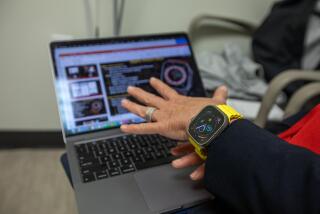Cutting Edge: Just what the doctor ordered: connectivity in medical devices
- Share via
In a few years, patients with chronic breathing problems will puff on an Internet-connected inhaler that instantly sends data about how often the device is used to the medicine provider and doctors who monitor care.
This is just one example of the potential benefits of bringing connectivity to medical devices. It is not lost on pharmaceutical and technology companies, which are working to get more medical Internet-of-Things devices to market.
Last month, Qualcomm Life and Novartis said they were teaming up to develop an Internet-connected Breezhaler to treat chronic obstructive pulmonary disease, or COPD. It will detect and report usage and other information. The data will go to a patient’s smartphone via a Novartis mobile app, which sends the data to the Internet cloud.
“By enabling near-real-time data capture from the patient and the connected Breezhaler device, patients can monitor their own adherence to the medication they take, which is vital to their health outcomes,” said David Epstein, head of Novartis Pharmaceuticals.
So far, however, the connected medical market has been slow to develop, with a raft of questions holding back adoption. They include concerns about regulation, security, privacy, liability and reimbursement.
“There have been numerous studies that have been positive, but there are a lot of ‘yeah, buts’ around,” said Victor Camlek, principal analyst on connected health for research firm Frost & Sullivan. “Although it is very promising, there is no one, simple reimbursement policy. It’s hard to make generalizations, but chronic conditions are probably going to be the leading thing driving this forward.”
Frost & Sullivan estimates the connected health market, excluding fitness trackers, at less than half a billion dollars in the U.S. today. But it predicts a compound annual growth rate of 13.2% over the next five years.
To date, the top proponent of remote patient monitoring has been the U.S. Veterans Administration. “They have been the early adopters in the United States,” Camlek said.
Others are moving more slowly. Novartis isn’t planning to release the connected inhaler until 2019.
“It’s a market issue that includes regulatory matters, and they are also doing payer trials,” said Rick Valencia, head of Qualcomm Life. “Trials to show [health insurers] the efficacy — the outcomes it generates — to motivate the right type of reimbursements.”
The cost savings and care improvements of connected medical devices are potentially significant, advocates say. Sending data to the Internet cloud lets health providers monitor vital symptoms and prod patients to take their medicine once they leave the hospital, potentially preventing costly readmissions.
“If someone has congestive heart failure, if the monitor indicates they are gaining weight — even a little bit of weight in a day or two — that is a very serious indicator of possible fluid buildup in the heart,” said Camlek of Frost & Sullivan. “That would trigger an alert for somebody to take an intervention step.”
Last year, Qualcomm Life began working with drug giant Roche on a connected coagulation meter that measures the viscosity of blood in stroke patients outside the hospital. The goal is to make sure that blood-thinning medicine is preventing further clots.
Using the meter, while vital to patients, isn’t fun. It requires a finger prick.
“If patients are very compliant, they’ll typically do two a day,” Valencia said. “If they’re not, they might do one. Having that radio link enables [caregivers] to remind the patient about doing their test. That’s the objective, to get them more compliant.”
Qualcomm Life is also helping a large managed healthcare company that aims to offer some customers discounts on their health insurance premiums based on how active they are.
It’s working to develop a sophisticated activity tracker that monitors not only steps taken but also the vigor and duration of exercise, among other things. The tracker learns the gait of the user to prevent fraud.
Longer term, reams of connected health data can be tapped to create predictive analytics software that scours data and spots telltale warning signs of pending problems.
But there are hurdles to wider adoption. Tele-medicine insurance reimbursement policies vary by state and, in some cases, the age of patients. Hospital administrators are concerned about the work flow and liability challenges of tracking hundreds of home-monitored patients.
Security is also a worry. Qualcomm Life’s 2net platform has security baked in and meets federal privacy standards. But some older connected medical devices with off-the-shelf Bluetooth radios could be less secure.
“You’re as strong as your weakest link,” Valencia said, “and where there are weak links in the industry still [they] are the medical device itself.”






